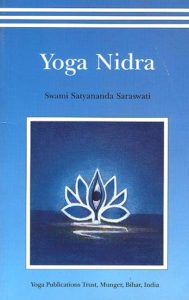Yoga nidra means yoga sleep in Sanskrit and it is an extremely valuable practice for health and healing. Yoga nidra helps to heal the physical, emotional and mental bodies of a person and it is a great tool for anyone wanting to enhance their yoga and meditation practice.
First of all, it should be understood that Yoga nidra is not just simply a technique that one uses or teaches but rather a state of consciousness that initiates higher states of awareness.
Yoga nidra is a form of Pratyahara –the 5th step of Raja Yoga and it is a method by which we can internalize our awareness and discover what is happening to us mentally.
Similar to hypnosis, yoga nidra works on our subconscious so it is very important that one who is teaching or guiding a yoga nidra session is experienced, preferably certified and has some formal training.
It’s disconcerting to see or hear someone teach who doesn’t know the science of this practice and who doesn’t teach in a systematic way. I can’t stress enough the importance of learning yoga nidra from a qualified teacher or reputable course. It’s not something you can just read about or simply pick up a yoga nidra book and teach from.
You need to understand the science, the various stages involved and have your own personal experience to draw upon. Yoga nidra is a science of the mind and brain. When you are guiding or teaching it, you are playing with a person’s psyche.
I have been practicing yoga nidra for over 12 years and have had much guidance from my advanced teachers both in Canada and India. Still, I only teach very basic and beginners yoga nidra because I am tapping into people’s subconscious mind’s and creating samskaras or imprints in their minds.
For those who are interested in learning more about yoga nidra or how to teach, I suggest taking a Yoga Nidra course such as one through the Yoga Academy of North America. My wife Aman took this course and it gave her the clarity, wisdom and guidance to teach it properly.
According to the yoga nidra taught in the Satyananda tradition through the Bihar School of Yoga, there are 8 essential and systematic stages one must be taken through. It is in the beginning stage that a Sankalpa – a firm will or resolve is introduced.
The other stages help to plant and cultivate the seed for you Sankalpa. Establishing your Sankalpa is very important because it helps you to cultivate a positive quality and is reinforced by your higher consciousness. Your Sankalpa can also help you accomplish and achieve great things in life as it reshapes your personality and gives you direction for positive results.
The Sankalpa is to be stated twice in a yoga nidra session – near the beginning and end when your mind is calm, quite, relaxed and receptive. It’s not an intellectual resolve which rarely brings results, rather it is a resolution planted deep into the subconscious with strong will power and feeling. This helps to bring this affirmation into fruition as the seed can be cultivated in daily activities.
There are many other benefits of yoga nidra which include increasing memory, concentration and cognitive function as well as helping one to get rid of bad habits and negative believe systems. It can also help one to balance their sympathetic and parasympathetic nervous system as well as develop emotional control such as controlling ones anger, jealousy and anxiety.
My teacher, a renowned Swami from India used yoga nidra to learn how to speak Italian in a few nights. He speaks over ten languages fluently. He also used yoga nidra to move into a state of consciousness where he didn’t have to use any anesthesia for his open heart surgery.
Finally yoga nidra is meant to ultimately be used as a spiritual practice to connect us to our inner most being – our true Self and take us to that place of peace, truth and bliss.

